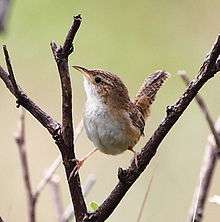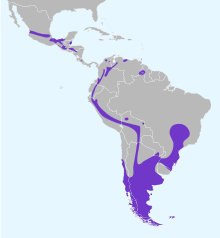Grass wren
The grass wren (Cistothorus platensis) is a species of passerine bird in the family Troglodytidae. It is widely distributed in central and southern America.
| Grass wren | |
|---|---|
 | |
| at Serra da Canastra National Park - MG - Brasil | |
| Scientific classification | |
| Kingdom: | Animalia |
| Phylum: | Chordata |
| Class: | Aves |
| Order: | Passeriformes |
| Family: | Troglodytidae |
| Genus: | Cistothorus |
| Species: | C. platensis |
| Binomial name | |
| Cistothorus platensis (Latham, 1790) | |
 | |
The species was described in 1790 by the English ornithologist John Latham and given the binomial name Sylvia platensis.[2] The type locality is Buenos Aires, Argentina.[3] The current genus Cistothorus was introduced by the German ornithologist Jean Cabanis in 1850.[4] The grass wren and the sedge wren were formerly treated as conspecific. They were split based on the results of a molecular phylogenetic study published in 2014.[5][6] There are 17 recognised subspecies of the grass wren.[6]
Grass wrens build two types of non‐breeding nest structures: platforms and dummy nests. Platforms are rudimentary accumulations of grasses concealed between vegetation. Dummy and breeding nests are dome‐shaped with a similar structural layer. The function of these non-breeding nests is unclear, but an experimental study suggests that building non‐breeding nests may be an attempt by males to manipulate the decision of females to breed with a mate they might otherwise reject or to start reproduction earlier than optimal for the females.[7]
References
- BirdLife International (2016). "Cistothorus platensis". IUCN Red List of Threatened Species. 2016. Retrieved 30 December 2017.
- Latham, John (1790). Index Ornithologicus, Sive Systema Ornithologiae: Complectens Avium Divisionem In Classes, Ordines, Genera, Species, Ipsarumque Varietates (in Latin). Volume 2. London: Leigh & Sotheby. p. 548.
- Mayr, Ernst; Greenway, James C. Jr, eds. (1960). Check-list of Birds of the World. Volume 9. Cambridge, Massachusetts: Museum of Comparative Zoology. p. 393.
- Cabanis, Jean (1850). Museum Heineanum : Verzeichniss der ornithologischen Sammlung des Oberamtmann Ferdinand Heine, auf Gut St. Burchard vor Halberstadt (in German). Volume 1. Halbertstadt: In Commission bei R. Frantz. p. 77.
- Robbins, Mark B.; Nyári, Árpád S. (2014). "Canada to Tierra del Fuego: species limits and historical biogeography of the Sedge Wren (Cistothorus platensis)". Wilson Journal of Ornithology. 126 (4): 649–662. doi:10.1676/13-162.1.
- Gill, Frank; Donsker, David, eds. (2017). "Dapple-throats, sugarbirds, fairy-bluebirds, kinglets, hyliotas, wrens & gnatcatchers". World Bird List Version 7.3. International Ornithologists' Union. Retrieved 29 December 2017.
- Llambías, Paulo Emilio; Jefferies, María Milagros; Apaza, Daniel Pascual Cáceres; Garrido, Paula Sabrina; Zarco, Agustín; Arrieta, Ramiro Santiago; Bender, José Benjamin (2020). "Building multiple nests is associated with reduced breeding performance in a south temperate population of Grass Wrens Cistothorus platensis platensis". Ibis. 162 (1): 75–89. doi:10.1111/ibi.12722. ISSN 1474-919X.
Further reading
- Kroodsma, D.; Brewer, D. (2017). del Hoyo, J.; Elliott, A.; Sargatal, J.; Christie, D.A.; de Juana, E. (eds.). "Grass Wren (Cistothorus platensis)". Handbook of the Birds of the World Alive. Lynx Edicions. Retrieved 31 December 2017.
- Kroodsma, Donald E.; Sánchez, Julio; Stemple, David W.; Goodwin, Elijah; Silva, Maria Luisa da; Vielliard, Jacques M.E. (1999). "Sedentary life style of Neotropical sedge wrens promotes song imitation". Animal Behaviour. 57 (4): 855–863. doi:10.1006/anbe.1998.1036.
- Traylor, Melvin A. Jnr. (1988). Geographic variation and evolution in South American Cistothorus platensis (Aves, Troglodytidae). Fieldiana Zoology Number 48. Chicago, Illinois: Field Museum of Natural History. pp. 19–28.
